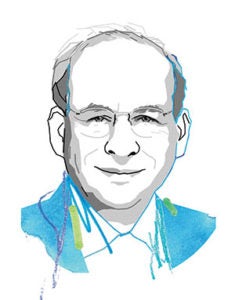
Our Global Connections
By David W. Leebron
One of the effects of the pandemic has been to keep us closer to home, and even now most people have not resumed international travel. For three semesters and two summers, our international programs were largely canceled. Many destinations still present insuperable barriers such as travel bans or long quarantine periods, and there are very few countries one can visit without significant complications and risks.

For a year and a half, my international travel consisted of the places I visited through my virtual Zoom backgrounds — Sydney, Prague, the Great Wall of China, the Acropolis of Athens and Borobudur Temple in Indonesia. Our students have had to delay or forgo their dreams of study and travel abroad. For our faculty, it has hampered their interactions with colleagues around the world seeking to better understand and address common challenges.
Internationalization permeates every aspect of what we do, from our campus community in Houston to faculty and students engaged in programs around the globe. I have previously written that our faculty is conservatively estimated as consisting of about one-third immigrants — counting only those who received their first higher education degree outside the United States. This is the result of seeking out the best talent in their respective fields, but it brings the benefit of different cultural perspectives into every facet of the university, from the magisters and associates in the residential colleges to the representation in the Faculty Senate.
Universities have long played a role in fostering international connections, even when political relationships were hostile. And no country has played a greater role in bringing students together from around the world than the United States. At Rice, typically between 10% and 12% of our undergraduates and about 40% of our graduate students are international. Even in the midst of doubts about international study during the pandemic, our international undergraduate applications surged 30% this past academic year, and Rice’s yield — the number who chose to enroll — of those students jumped from 44% to 54%. The number of international students from Africa and Latin America doubled and tripled, respectively.
For a year and a half, my international travel consisted of the places I visited through my virtual Zoom backgrounds — Sydney, Prague, the Great Wall of China, the Acropolis of Athens and Borobudur Temple in Indonesia.
With about a quarter of our total student body being international, Rice is essentially an international campus located in one of the country’s most international cities. The daily interactions with these students enrich conversations and learning from the classroom to the dinner table and foster a global sense of connectedness and compassion. And international aspects are deeply infused into our curriculum at both the undergraduate and graduate level, including the 6-year-old Master of Global Affairs sponsored by the School of Social Sciences and the Baker Institute.
But it remains equally essential that our students and faculty have the opportunity to engage abroad. Our efforts at such internationalization through study and research abroad are also suffused throughout every part of the university and every aspect of our mission — education, research and service. Here I can relate just a few examples.
And no country has played a greater role in bringing students together from around the world than the United States. At Rice, typically between 10% and 12% of our undergraduates and about 40% of our graduate students are international.
On the faculty collaboration side, almost two years ago, we formally established a relationship with IIT Kanpur to focus on a group of issues on sustainability and the environment, and in particular developing materials and processes for photovoltaics, energy storage, alternative fuels, water treatment and more.
The Rice School of Architecture has been the only part of Rice to have a permanent presence abroad. Since 2002, Rice architecture students have benefited from the extraordinary learning opportunity that is a semester in Paris — a city with two millennia of architecture and urban structure, from the Roman ruins of the ancient city of Lutetia to modern icons such as the Pompidou Center and the I.M. Pei pyramid at the Louvre. We’re now exploring how we might build on the Rice architecture base in Paris to expand opportunities to other students as well, and to create a model for other cities.
In the School of Social Sciences, the Urban Politics and Policy Lab combines theory and methods with case studies, enabling students to better understand the difficulties posed by large metropolises and the commonalities and differences between cities across continents and cultures. The course typically includes an urban lab in Istanbul led by Professor Melissa Marschall, who herself holds a degree from Bogazici University in Istanbul.
We’re now exploring how we might build on the Rice architecture base in Paris to expand opportunities to other students as well, and to create a model for other cities.
Across the campus, part of the Jones School’s core curriculum is an immersive short global course focusing on emerging markets, whether in Latin America, Africa or Asia. And, of course, the Center for Languages and Intercultural Communication (CLIC) offers Rice in Country programs to help deepen our students’ familiarity with language and culture.
This is just the tip of the iceberg. During the pandemic, we have sought to maintain our international engagement and education through Zoom connections to students and professors around the world. We must continue the process of expanding our global opportunities and engagement and make sure every student can access them. Only by doing that can we educate our students to navigate the world they will confront and solve the problems that span our planet.
